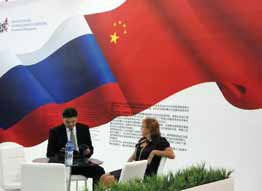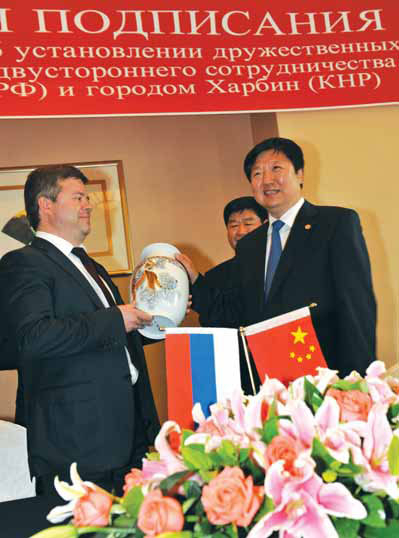Harbin building stronger ties with northern neighbor
Updated: 2013-03-23 07:51
(China Daily)
|
|||||||||||
|
Russians stage an exhibition at the 23rd China Harbin International Economic and Trade Fair in June 2012. Wang Kai / Xinhua |
|
Song Xibin (right), mayor of Harbin, meets with Russian delegates. Photos Provided to China Daily |
Editor's note: In the following special feature, Harbin Mayor Song Xibin writes about the crucial role of the city as a bridge between China and Russia
As neighbors and leading members of BRICS, China and Russia have a relationship that is unlike any other in the world.
Cooperation between these countries is essential to their fundamental interests, and it is an important strategy that can benefit their people.
Based on the principle of mutual benefit, the two countries have signed agreements on comprehensive strategic partnerships, investment and cooperation between Northeast China and the Far East region of Russia as well as eastern Siberia.
The two countries have made great strides in terms expanding bilateral trade and direct investment while they have worked to promote such high-tech emerging industries as alternative energy as well as aerospace and aeronautics.
Bilateral exchanges and cooperation between the two have reached new heights.
The State visit of Chinese President Xi Jinping to Russia indicates that leaders of the two countries are placing a strong emphasis on developing comprehensive strategic partnerships while creating better conditions for bilateral cooperation and greater opportunities of development.
As a key hub for Sino-Russian strategic cooperation, Harbin provides a solid base for trade, and it enjoys obvious advantages in terms of technological partnerships.
The area's geographical advantages are apparent. Heilongjiang province has nearly 3,000 kilometers of border with Russia. As capital of the province, Harbin is an important stop on the Eurasian Land Bridge, a railway linking the two continents, and its airport is a vital hub in the airline corridor.
The city is also a gateway for Russian businesses to bring in products through Heilongjiang's ports. Harbin offers advanced transportation facilities, such as Taiping Airport, China's closes airport to its northern neighbor. The airport provides links between the country and Russia's Far East as well as North America.
Taiping has been upgraded into a national portal airport. The city also has an inland port for container service, a golden waterway as well as railways and roads, forming a well-developed transport network that connects to Russia and radiates out through Northeast Asia.
The city has a solid industrial basis, as well.
As China's traditional industrial center, Harbin houses 13 industrial projects that were supported by the Soviet Union in the early days of New China as well as 16 top industrial plants that were relocated from southern China.
After years of development, complete industrial chains have formed, covering equipment manufacturing, food, pharmaceuticals and oil chemistry. Civil aviation, alternative-energy equipment, new materials, electronic information, biological products, green food and other emerging industries are starting to rapidly develop as well. The modern service sector also offers great space for cooperation with Russian businesses.
Harbin also enjoys close scientific and technological ties with Russia.
The city is home to a batch of universities and researchers. A total of 38 academicians from the Chinese Academy of Sciences and Chinese Academy of Social Sciences live in the city.
The city has made great contributions to the Shenzhou, Feitian, Chang'e and Jiaolong projects, which are key elements of China's space exploration missions. Nine Sino-Russian sci-tech centers have been set up in Harbin, and five international collaboration centers are located in the city.
Harbin has exchange and cooperation programs with some 180 research institutes with overseas counterparts, including the Commonwealth of the Independent States and some Eastern European countries.
Friendly exchanges between the country are frequent.
Harbin, has historically been a business hub in the Far East, and its trade with Russia once accounted for 75 percent of the nation's total. After the reforms and opening-up in the late 1970s, it expanded its exchanges and cooperation with its northern neighbor. Since then, it has established relations with four states and built sister city relationships with some 10 cities there.
Cooperation between Harbin and its sister cities has flourished in the sectors of food, equipment manufacturing and timber processing. In particular, the 23rd China Harbin International Economic and Trade Fair and the eighth China Harbin International Scientific and Technological Achievements Fair last year lifted the city's international profile and helped it to boost exports to Russia.
Harbin also has other advantages that make it ideal as a base for relations with Russia.
For one, locals have long been passionate about studying the Russia language. It has a wealth of personnel who speak excellent Russian and have deep knowledge of Russian culture as well as abundant experience in Sino-Russian trade, science and technology, and cultural exchanges.
Harbin Bank has the most preferential policies in terms of trade with Russia. To date, it has established business ties with major commercial banks in the fields of account exchange, settlement and clearance, and its businesses account for a large portion of China's financial business.
Harbin, has unparalleled historical opportunities as a leader in North China's development and an exemplar of the evolution of coastal areas.
China is constantly strengthening its policies to further open itself to Russia.
In March 2010, during Xi's visit to Russia's coastal areas, he noted that the development of Sino-Russian cooperation benefits the people of the two countries and other neighbors. He said progress has been made in opening northern coastal areas.
In 2012, a revitalization plan for Northeast China was approved for the 12th Five-Year Plan period (2011-15). National leaders said that the country should continue to open up the northern coastal area by establishing important hubs for boosting trade with Northeast Asia and building model zones for Sino-Russian cooperation.
Recently, China began to draft a new plan for the revitalization of Northeast China over the next 10 years, which includes development strategies in Heilongjiang and the eastern Inner Mongolia autonomous region. Harbin will play a pivotal role in this.
Also, Russia's accession to the WTO and its drive to further develop the Far East region have provided more opportunities.
In August 2012, Russia joined the WTO, which changed policies regarding tariffs, market accession and investment climate. This accelerated the normalization and optimization of its market order.
Russian President Vladimir Putin said the country should draw on China's momentum to boost Russia's economy. He said developing Russia's Far East region should be considered the most geographically important political task, and he expects to utilize China's capital and market advantage to drive Russia's economic modernization.
Currently, Russia has set up special government authorities to push the development of the Far East region. In the area as well as in eastern Siberia, Russia plans to introduce enterprises devoted to ports, roads, telecommunications, airport construction and project promotion.
Because the area's development has been made a priority in Russia's national strategy, Harbin stands to benefit due to its proximity.
In recent years, there has been collaboration between the two countries in trade, investment, and science and technology projects. The size of and achievements made by these projects have attracted attention from around the globe.
In 2012, bilateral trade hit $88 billion, an increase of 11.2 percent. China has been the largest trade partner of Russia for the past two years.
During a time of shrinking global demand and strong trade protectionism, the kind of growth in bilateral trade that the two nations have seen is hard to come by. This trade not only promotes the stable economic development of the two countries but has also given positive momentum to economic recovery worldwide.
During the 17th regular meeting between Chinese and Russian prime ministers in December 2012, the two countries signed 14 cooperation agreements covering trade, investment, energy, high technology, finance and cultural areas. These agreements have significantly expanded bilateral cooperation and injected vigor into development.
An important city dedicated to Sino-Russian cooperation, Harbin is committed to working together with its partner to the north to jointly create a brilliant future.
Currently, we are striving to build the city into a model area for boosting the country's trade with Russia as well as a hub for international commodities trade with Russia, Eastern Europe and East Asia. We also intend to make Harbin a center for modern logistics and industry. We sincerely hope the two sides can join hands in a partnership that will bring about mutual benefit by increasing the scope and depth of strategic cooperation.
First, Harbin will strengthen trade with the country.
It will perfect transportation corridors for aviation, land and sea traffic. A well-developed international aviation channel connecting Russia, Northeast Asia, and North America is being planned.
Harbin's city government will build centers for large commodities trade, export processing and logistics as well as trade cooperation and exchange with Russia. It will speed up construction of Sino-Russian exhibition centers, financial services and electronic information platforms.
Second, Harbin will enhance industrial cooperation with Russia.
In addition to traditional industries like electronics, machinery and chemicals, Harbin will promote the development of aerospace and astronautics, alternative energy equipment, new materials, energy conservation, environmental protection, biological pharmaceuticals, green food, electronic information and modern agricultural equipment sectors. The construction of a new Sino-Russia Industrial Park is under way.
Third, it will boost sci-tech cooperation. Technology is the driving force for Sino-Russian trade. The city's top priorities are to speed up the development of a sci-tech cooperation center, to promote the commercialization of technological achievements, to integrate more resources as well as to introduce, research, develop and foster a series of industrial cooperation centers.
In the meantime, it will improve the design of the China Harbin International Scientific and Technological Achievements Fair, providing a boost to sci-tech trade for Northeast Asia areas.
The city will promote cultural and tourism cooperation.
It will place emphasis on the cultural exchanges with the cities of Krasnoyarskiy and Khabarovskiy. It will send delegates to visit these places and enhance cooperation. Harbin also plans to seek out opportunities in Russia's China Tourism Year from 2012 to 2013, during which the city hopes to attract Russian investors, jointly develop tourism resources and put bilateral tourism on a healthy track for faster and better development.
The Harbin city government urges Russia's leaders to seize the opportunities presented by the warming of Sino-Russian relations, in particular President Xi's recent visit, and join with us to boost practical cooperation. I sincerely hope that we can strengthen trust on the basis of mutual support and work together for common prosperity in a strategic partnership that can weather the test of time.
(China Daily 03/23/2013 page12)

